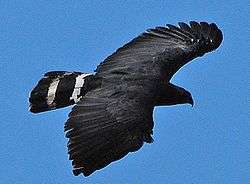Crane hawk
| Crane hawk | |
|---|---|
.jpg) | |
| Scientific classification | |
| Kingdom: | Animalia |
| Phylum: | Chordata |
| Class: | Aves |
| Order: | Accipitriformes |
| Family: | Accipitridae |
| Subfamily: | Circinae |
| Genus: | Geranospiza Kaup, 1847 |
| Species: | G. caerulescens |
| Binomial name | |
| Geranospiza caerulescens (Vieillot, 1817) | |
The crane hawk (Geranospiza caerulescens) is a species of bird of prey in the Accipitridae family. It is monotypic within the genus Geranospiza.[2]

Taxonomy
The crane hawk used to be many species that were recently lumped into one. Those species are now designated as subspecies. Color varies clinally, though, and it is now commonly accepted that they comprise one species. There are also two species of harrier-hawks in Africa of the genus Polyboroides that, while they are morphologically and behaviorally similar, are not very closely related. They serve as a good example of convergent evolution.[3]
Habitat and Distribution
Crane Hawks occur in tropical lowlands at the edge of forests and are almost always closely associated with water. It is found in Argentina, Belize, Bolivia, Brazil, Colombia, Costa Rica, Ecuador, El Salvador, French Guiana, Guatemala, Guyana, Honduras, Mexico, Nicaragua, Panama, Paraguay, Peru, Suriname, Trinidad, Uruguay, and Venezuela. They are an irruptive and local migrant, probably moving in response to changing water conditions.[3]
Behavior
These hawks often forage by scanning from a perch or on the wing and swooping down to grab prey. However, they are notable for having “double-jointed” tarsal bones, allowing them to reach into tree cavities and extract prey, a trait they share only with the genus of African harrier-hawks Polyboroids. Their main prey are small vertebrates, especially rodents, bats, lizards, snakes, and small birds, but they have also been known to eat larger insects and other arthropods and snails.[3]
During breeding, nests are built in tree canopies, often in clumps of orchids or other epiphytes. The nest is a shallow cup of twigs, anywhere from 10–25 metres up in a tree. Clutches are usually 1-2 white-or-bluish-tinged eggs.[3]
Conservation
No where is the Crane Hawk particularly common, but it is still widely distributed. However, it is considered threatened in Mexico, endangered in El Salvador, and at low risk in Argentina.[3]
References
- ↑ BirdLife International (2012). "Geranospiza caerulescens". IUCN Red List of Threatened Species. Version 2013.2. International Union for Conservation of Nature. Retrieved 26 November 2013.
- ↑ "ITIS Report: Geranospiza". Integrated Taxonomic Information System. Retrieved 8 August 2014.
- 1 2 3 4 5 Gomez, Cesar. "Geranospiza caerulescens". Global Raptor Information Network. The Peregrine Fund. Retrieved November 1, 2015.
External links
| Wikimedia Commons has media related to Geranospiza caerulescens. |
